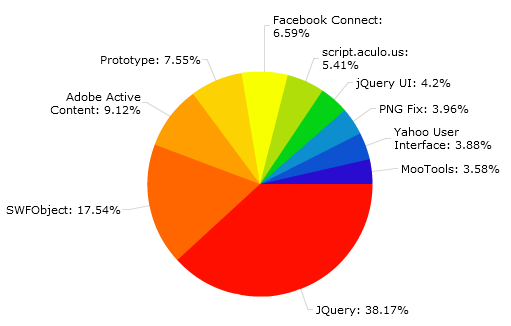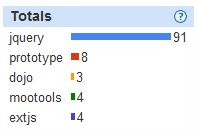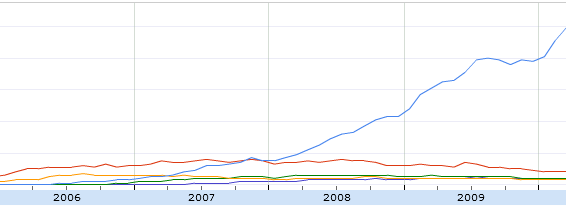 Five years ago, no one had heard about jQuery. It was just an idea in the back of Javascript guru John Resig’s head. Today, jQuery is by far the most popular Javascript library in the world and is used by over 28% of all websites on the internet.
Five years ago, no one had heard about jQuery. It was just an idea in the back of Javascript guru John Resig’s head. Today, jQuery is by far the most popular Javascript library in the world and is used by over 28% of all websites on the internet.
jQuery is open source, web developers love it, it’s been embraced by a slew of big companies, and is close to becoming a de facto standard for website development. It doesn’t just have the support of the open source developer community behind it, it’s even received official support from Microsoft.
So, what exactly is jQuery? The jQuery team probably says it best:
jQuery is a fast and concise JavaScript Library that simplifies HTML document traversing, event handling, animating, and Ajax interactions for rapid web development. jQuery is designed to change the way that you write JavaScript.
Websites that use jQuery
More and more websites are using jQuery, and a large portion of the most popular websites in the world is using it. For example:
Twitter.com, Wikipedia.org, MLB.com, Amazon.com, Bing.com, Microsoft.com, Bit.ly, ESPN.com, Digg.com, Reddit.com, Netflix.com, WordPress.com and many others.
Even the US government uses it (Whitehouse.gov).
As we mentioned in the introduction, more than 28% of all websites use jQuery, and that trend is pointing upwards. Strictly speaking, this statistic is based on the top 10,000 websites, but it’ll be reasonably close.

Above: jQuery usage graph from BuiltWith.
What about other Javascript libraries?
jQuery is by far the most popular JavaScript library in use today, any category. Out of all sites that use Javascript libraries and functions, more than 38% use jQuery. As an example of how dominant jQuery has become, the closest similar Javascript library is Prototype, with 7.55%.

Above: Javascript library and function distribution from BuiltWith.
And when it comes to overall buzz, jQuery’s dominance is even more pronounced. A couple of years ago, everyone was talking about Prototype, but not anymore. If you look at sheer interest, jQuery has crushed the competition.
 The below graph shows interest for jQuery compared with Prototype, Dojo, MooTools, and ExtJS. The little diagram here to the right shows you which color in the graph corresponds to which library, and also the standing now in 2010.
The below graph shows interest for jQuery compared with Prototype, Dojo, MooTools, and ExtJS. The little diagram here to the right shows you which color in the graph corresponds to which library, and also the standing now in 2010.
This chart and the diagram to the right have been filtered to only show results for the “Web Design and Development” category in Google Insights for Search (since “prototype” is such a common word).

Above: jQuery is the blue, sharply climbing curve. The red one is Prototype.
jQuery gets lots of help from companies
Not only has jQuery been embraced by indie developers everywhere, it has managed to find that golden balance where it’s also been equally popular on the enterprise end. This is surely one of the keys to its success and with the backing of so many large companies, jQuery has been able to blossom.
Here are a few examples of how companies are helping or sponsoring the jQuery project.
- Both Microsoft and Google serve the jQuery library from their Content Delivery Networks, free for any site to use.
- Media Temple is donating all resources necessary to host the jQuery website.
- Microsoft has committed to help with QA testing and even code development. It also includes jQuery as part of Visual Studio and ASP.NET MVC.
- Nokia is contributing with testing and has also hired one of the core developers, Brandon Aaron.
- And of course there’s open source champion Mozilla, where lead developer and jQuery creator John Resig works.
These were just some of the prominent ones. There are more sponsors of the jQuery project. For example, Pingdom (hey, that’s us!) is also a sponsor.
According to John Resig, 100% of jQuery’s resources come in through donations. And it’s not all about getting support from big companies. Anyone can donate to the jQuery project.
A small team, but a big success
The jQuery core development team consists of only six programmers, including jQuery creator John Resig. There is also a developer relations team of six people.
Then there are people working on a few other aspects of jQuery, like plugins, but overall, the team isn’t all that big. And remember, this is an open source project, where the contributors are volunteering their efforts.
You can read more about the jQuery team on their homepage.
Final words
This could very well be it, the one core Javascript library to rule them all and become, if not an official standard, at least an unofficial industry standard for web developers.
With its current adoption rate, it will most likely become even more dominant this year, especially among any new web projects.




























